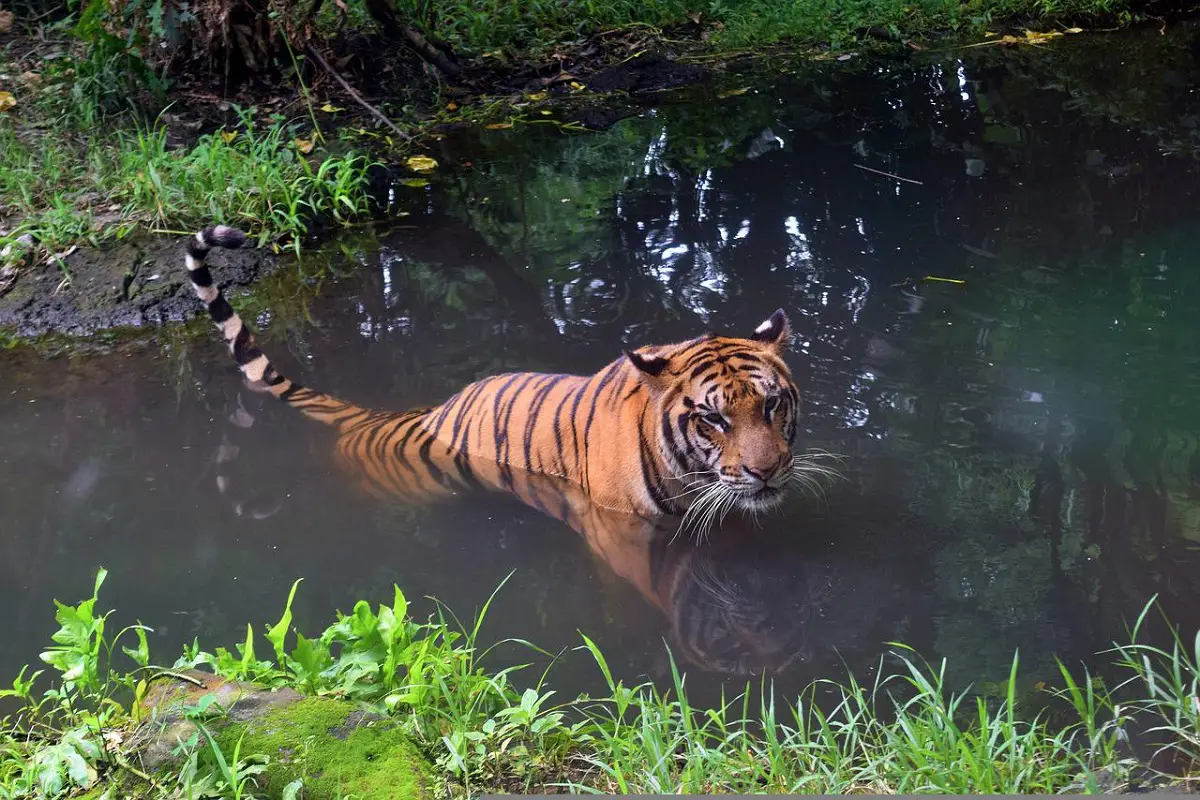You might not be surprised to know this, but the Malayan tiger is the national animal of Malaysia.
Whilst once it was said to be a subspecies of the Indonesian tiger, it was debunked back in 2004.

They are however, a subspecies of the mainland tiger, and those that are wild live in the area of southeast Asia.
They are also one of the smallest tigers ever known, and are currently endangered – but we shall get to that later in the article.
Malayan tigers can also swim, and are known to be really good at it.
With all this in mind, let’s take a look at the Malayan tiger, and find out everything that you need to know about them.
How Many Malayan Tigers Are Left In The World?
As with a lot of tigers, there are only around 150 wild Malayan tigers left across the world. Sadly, this isn’t very many, meaning they are on the endangered list.
According to the IUCN (International Union for Conservation of Nature), there are as little as 80 to 120 adults left that can breed.
Not just that, the numbers are declining too. Every year there is likely to be less Malayan tigers alive in the wild.
Without anyone knowing the exact figures, there are close to 70 or 80 Malayan tigers in captivity. This is both across the United States and abroad.
It is likely a lot of these are in zoos and safari parks. Whilst they can be controversial, it does mean that they are protected to live longer.
Despite that, breeding isn’t always possible to get a purebred tiger breed.
This means that it can be complex to carry the breed forward to make sure they do not become fully extinct.
Why Are Malayan Tigers Becoming Extinct?
There are a number of reasons why Malayan tigers are becoming extinct, and it is mainly at the hands of humans.
This is because Malayan tigers especially are hunted to be used in Chinese medicine production.
Poaching makes up a big part of the reason why tigers in general are declining – not just the Malayan tiger.
The majority of those who poach come from outside of Malaysia to set up camp and kill tigers.
It is illegal to do so, but the act is still happening despite the efforts of many to stop it. Most of the time it is about money and financial gain.
It used to be about taking the fur and skin of an animal to sell on for a lot of money.
More people are becoming aware of the cruelty that wearing fur supports, and this has caused incidents to decline.
Even so, tigers are still being poached for financial gain, or out of fear of tigers and hunters wanting their numbers to decline.
Another reason is due to human impact. The plantations used for palm oil are taking over the forests where the tigers live.
This is removing their natural habitats and causing tigers to die off.
This means less places for them to live and hunt, as removing territories also causes a lack of prey.
If the tigers cannot eat, then they will starve to death, or take desperate measures. If there is domesticated livestock nearby, then they will attack them.
In doing so, humans may shoot them or start leaving poison out to kill the tiger.
How Rare Is A Malayan Tiger?
A Malayan tiger is said to be extra special due to their declining numbers, but this is also said about other species too.
Once they become endangered, the majority of people will do anything to keep them going.
The Malayan tiger however, is considered as an original sub-species, of which there are nine of them.
Three are completely extinct, with another, the South China tiger, speculated to be potentially extinct.
Sadly, the Malayan tiger is disappearing at a fast rate.
This makes them very rare to see, as there just isn’t that many left in the wild.
If you do want to see a Malayan tiger, then read on to find out where it is possible.
What’s The Difference Between A Malayan Tiger And Other Tigers?

Whilst it can be difficult to tell the difference between a lot of tigers just by looking at pictures, there are some notable differences.
The Malayan tiger has the orange fur and black stripes, along with a lighter underbelly. However, they are noticeably smaller than most tigers.
That being said, they are not the smallest. The Sumatran still holds the record for the smallest tiger.
The Malayan tiger is around 1.7 to 2 meters long depending on whether it is a male or female, and weighs up to 129 kg.
If you are not sure how that compares to other tigers, then let’s look at the Bengal tiger which originates from India.
It can reach up to 3 meters or so long, and can weigh up to 310 kg. That’s quite a big difference!
The small size does mean that the tigers’ stripes are smaller and thinner, and that puts them in good stead when it comes to making their way through jungles and forests.
They can blend within the foliage of dense growth amongst the trees.
Other than that, there is no real difference when it comes to the Malayan tiger and other tigers.
They all have wickedly sharp claws and teeth, and all hunt in a similar fashion.
However, Malayan tigers are keen swimmers and are pretty good at it too.
You don’t often read about tigers in the water, but Malayan tigers love to venture out into streams and lakes. It’s really good for hunting, too.
How Do I Identify A Malayan Tiger?
Malayan tigers, like most, can be difficult to differentiate.
However, just like we discussed above, there are different things to spot when comparing the Malayan with other tigers.
To identify a Malayan tiger, you will want to look at their size. If they are smaller than an average tiger, then it is likely that it could be a Malayan tiger.
However, there are other small breeds like the Sumatran, so it can be easy to become confused.
They may also have narrow stripes that fit with their smaller body, along with their orange fur and white underbelly.
Another way to identify a Malayan tiger is where it lives. If it is in southeast Asia, and swimming in the water, then it is a Malayan tiger!
Where Can I See Malayan Tigers?
It is very unlikely that you will see a wild Malayan tiger.
Not only is this because their numbers are declining due to them being an endangered animal, but also because they are situated along the Malay Peninsula and the most southern area of Thailand.
However, if you want to spot a Malayan tiger in captivity, then you have some options. One of those is the San Diego zoo.
They have both the Malayan tiger and the Sumatran tiger.
If you are in the UK, then the Hamerton Zoo Park in Cambridgeshire also hosts two Malayn Tigers, and have done so since 2016.
Singapore has a Malayan tiger at the Mandai Wild Reserve, as do many other places. There might be a zoo or safari park near you!
How Much Is A Malayan Tiger Worth?
Unfortunately, like a lot of tigers, the Malyan tiger – as in their carcass – is worth quite a lot of money.
This is the problem with poachers being one of the main causes for their rapid decline.
Now that they are close to extinction, their worth has likely gone up due to rarity.
In fact, due to the carcass being worth around RM500,000 to RM800,000 (Around $100,000 to $180,000), foreigners who poach are happy to spend months camping to do whatever they can to kill the tiger.
It is a sad and unfortunate thing that money can come before the welfare of an animal. Once they become extinct, there is no turning back the clock.
Final Thoughts On Malayan Tigers
Malayan tigers are a rare sight, especially if you want to see them in the wild within the Malay Peninsula and the most southern area of Thailand.
You can however, see them in a public place if you want to travel to a zoo or safari park that has them in captivity.
There are only around 150 Malayan tigers in the wild, and this number is rapidly declining, year after year.
Due to poaching and general human impact, Malayan tigers are losing their habitats.
They are fascinating mammals that are smaller than most tigers, apart from the Sumatran.
Their stripes are narrower, yet they still have the stunning bright orange fur. They are also seen as very athletic and fast, and love to swim.
If you have enjoyed reading about the Malyan tiger, then why not take a look at the rest of the website.
We have lots of interesting facts about many of the wild big cats!
- Sink Your Teeth Into This: Analyzing the Powerful Lion Bite Force - September 8, 2023
- Siberian Tigers: Everything You Need To Know - September 4, 2023
- Do Lions Eat Humans? Understanding Lion Aggression and Risks - September 4, 2023








